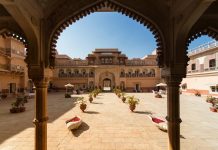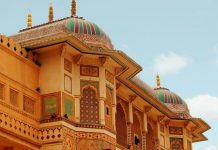Most of us know about the Ranthambore National Park in Rajasthan, Bandhavgarh National Park in Madhya Pradesh, Jim Corbett National in Uttarakhand, The Kaziranga National Park in Assam and The Sunderbans National Park in West Bengal, but did you know there are more places in India which are known for their wildlife? Here’s a list of places where you can see wildlife up close and personal
1. Satpura National Park, Madhya Pradesh
 (Image Credit: indianholiday.com)
(Image Credit: indianholiday.com)
The Satpura National park is located in the Hoshangabad district of Madhya Pradesh and its name is derived from the Satpura range. Surrounded by natural waterfalls, it is a beautiful place to be in. It is very rich in biodiversity and is home to animals like the leopard, sambar, chital, Indian muntjac, nilgai, four-horned antelope, Chinkara, wild boar, bear, black buck, fox, porcupine, flying squirrel,etc. One can stay at the V Resorts Jungle Retreat which is close by.
2. Periyar National Park, Kerala
 (Image Credit: keralatourism.org)
(Image Credit: keralatourism.org)
The Periyar National Park is a three-hour drive from Kochi on the hills of the Cardamom Hills. The wildlife trail at this park is a must do here. Deers, snakes, elephants, leopards, and tigers can be spotted here. If you are visiting the park, you can stay at the Periyar House which is set within the park
3. Gir National Park, Gujarat
 (Image Credit: travelkabaap.com)
(Image Credit: travelkabaap.com)
The Gir national park is home to the Air Lions and this is the best place to get up close and personal with the king of the jungle. The lion safari is something that me should not miss here. Besides lions you can even spot slot bears, leopards, hyenas, Asiatic Lions, crocodiles etc. The Gir Jungle Resort is the best place to stay if you want to be close to the jungle.
4. Hemis National Park, Jammu Kashmir
 (Image Credit: indiagetaways.co.in)
(Image Credit: indiagetaways.co.in)
Who would have thought that there would be a wildlife park way up high in Eastern Ladakh? This park is home to endangered animals like the Tibetan wolf, snow leopards, the red fox and the Asiatic Ibex. This is one of the most surreal safaris and is 5 km from the Lee district. You can also spot the blue sheep and Himalayan marmot besides the animals mentioned above. There are plenty of homestay facilities around the park to choose from besides a monastery that provides rooms to stay.
5. The Great Himalayan National Park, Himachal Pradesh
 (Image Credit: visitortrip.com)
(Image Credit: visitortrip.com)
Another wildlife park in the snowcapped mountains, this one is located in Kuala and is surrounded by coniferous forests. This park is home to the musk deer, snow leopard, Himalayan pit viper, and primates. One can either camp under the stars here or stay at the Forest House Saipora which is a dormitory and also boasts of a library.
6. Nanda Devi, Uttarakhand
 (Image Credit: indianholiday.com)
(Image Credit: indianholiday.com)
You’ve probably heard of the Jim Corbett National Park in Uttarakhand but have you heard of the Nanda Devi Park? This place is home to the Asiatic black bear, blue sheep, and the Himalayan musk deer. There are not many options to stay at this park but one can stay at hotels either in Joshimath or Badrinath.
7. Khangchendzonga National Park, Sikkim
 (Image Credit: wikimedia.org)
(Image Credit: wikimedia.org)
The Khangchendzonga National Park in Sikkim gets its name from the Kanchenjunga mountain range. This dark is known widely for the red pandas that can be spotted there. Other animals that can be seen and found here are the antelope, the snow leopard and the musk deer. One can either stay in hotels in Gangtok and travel to the park from there or there are a couple of rooms available to visitors at the Range Office and there are about four rest houses with around 20 beds. is able to stay at hotels at Gangtok, given that very few accommodation options are available at the Park. Mayfair Spa and Resort, Suhim Portico, Orange Villa Resort
Speaking to HFT, Mr. Ravikant Sinha, Chief Wildlife Warden, West Bengal said that the best time to visit the any wildlife sanctuaries and National parks is from the months between November to February, which is the colder or cooler months when the animals come out to bask in the sun and people can spot them. “If you are a wildlife enthusiast then you should always try and visit during non-peak season time when there are less tourists and less noise. The animals usually hide when they see too many people and there is too much noise,” he adds.














